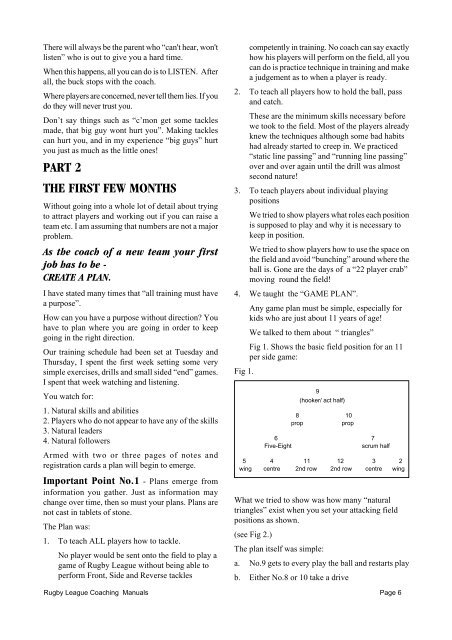Junior Coaching Book (1).pdf
Junior Coaching Book (1).pdf
Junior Coaching Book (1).pdf
You also want an ePaper? Increase the reach of your titles
YUMPU automatically turns print PDFs into web optimized ePapers that Google loves.
There will always be the parent who “can't hear, won't<br />
listen” who is out to give you a hard time.<br />
When this happens, all you can do is to LISTEN. After<br />
all, the buck stops with the coach.<br />
Where players are concerned, never tell them lies. If you<br />
do they will never trust you.<br />
Don’t say things such as “c’mon get some tackles<br />
made, that big guy wont hurt you”. Making tackles<br />
can hurt you, and in my experience “big guys” hurt<br />
you just as much as the little ones!<br />
PART 2<br />
THE FIRST FEW MONTHS<br />
Without going into a whole lot of detail about trying<br />
to attract players and working out if you can raise a<br />
team etc. I am assuming that numbers are not a major<br />
problem.<br />
As the coach of a new team your first<br />
job has to be -<br />
CREATE A PLAN.<br />
I have stated many times that “all training must have<br />
a purpose”.<br />
How can you have a purpose without direction? You<br />
have to plan where you are going in order to keep<br />
going in the right direction.<br />
Our training schedule had been set at Tuesday and<br />
Thursday, I spent the first week setting some very<br />
simple exercises, drills and small sided “end” games.<br />
I spent that week watching and listening.<br />
You watch for:<br />
1. Natural skills and abilities<br />
2. Players who do not appear to have any of the skills<br />
3. Natural leaders<br />
4. Natural followers<br />
Armed with two or three pages of notes and<br />
registration cards a plan will begin to emerge.<br />
Important Point No.1 - Plans emerge from<br />
information you gather. Just as information may<br />
change over time, then so must your plans. Plans are<br />
not cast in tablets of stone.<br />
The Plan was:<br />
1. To teach ALL players how to tackle.<br />
No player would be sent onto the field to play a<br />
game of Rugby League without being able to<br />
perform Front, Side and Reverse tackles<br />
competently in training. No coach can say exactly<br />
how his players will perform on the field, all you<br />
can do is practice technique in training and make<br />
a judgement as to when a player is ready.<br />
2. To teach all players how to hold the ball, pass<br />
and catch.<br />
These are the minimum skills necessary before<br />
we took to the field. Most of the players already<br />
knew the techniques although some bad habits<br />
had already started to creep in. We practiced<br />
“static line passing” and “running line passing”<br />
over and over again until the drill was almost<br />
second nature!<br />
3. To teach players about individual playing<br />
positions<br />
We tried to show players what roles each position<br />
is supposed to play and why it is necessary to<br />
keep in position.<br />
We tried to show players how to use the space on<br />
the field and avoid “bunching” around where the<br />
ball is. Gone are the days of a “22 player crab”<br />
moving round the field!<br />
4. We taught the “GAME PLAN”.<br />
Any game plan must be simple, especially for<br />
kids who are just about 11 years of age!<br />
We talked to them about “ triangles”<br />
Fig 1. Shows the basic field position for an 11<br />
per side game:<br />
Fig 1.<br />
9<br />
(hooker/ act half)<br />
8 10<br />
prop prop<br />
6 7<br />
Five-Eight scrum half<br />
5 4 11 12 3 2<br />
wing centre 2nd row 2nd row centre wing<br />
What we tried to show was how many “natural<br />
triangles” exist when you set your attacking field<br />
positions as shown.<br />
(see Fig 2.)<br />
The plan itself was simple:<br />
a. No.9 gets to every play the ball and restarts play<br />
b. Either No.8 or 10 take a drive<br />
Rugby League <strong>Coaching</strong> Manuals Page 6


